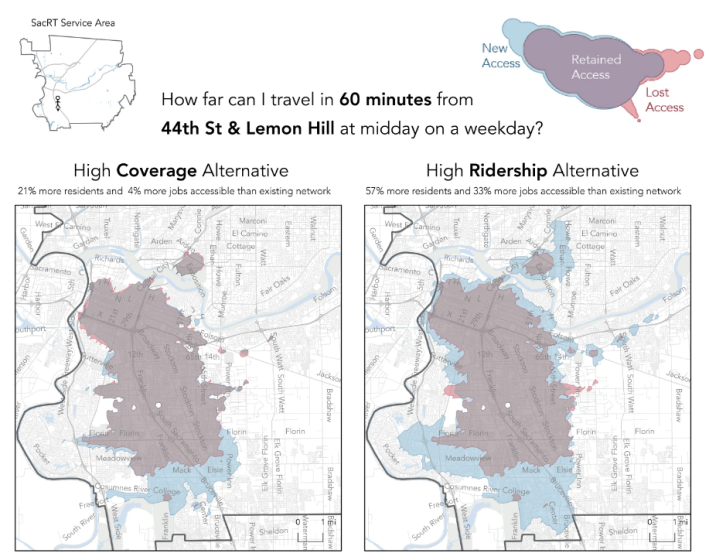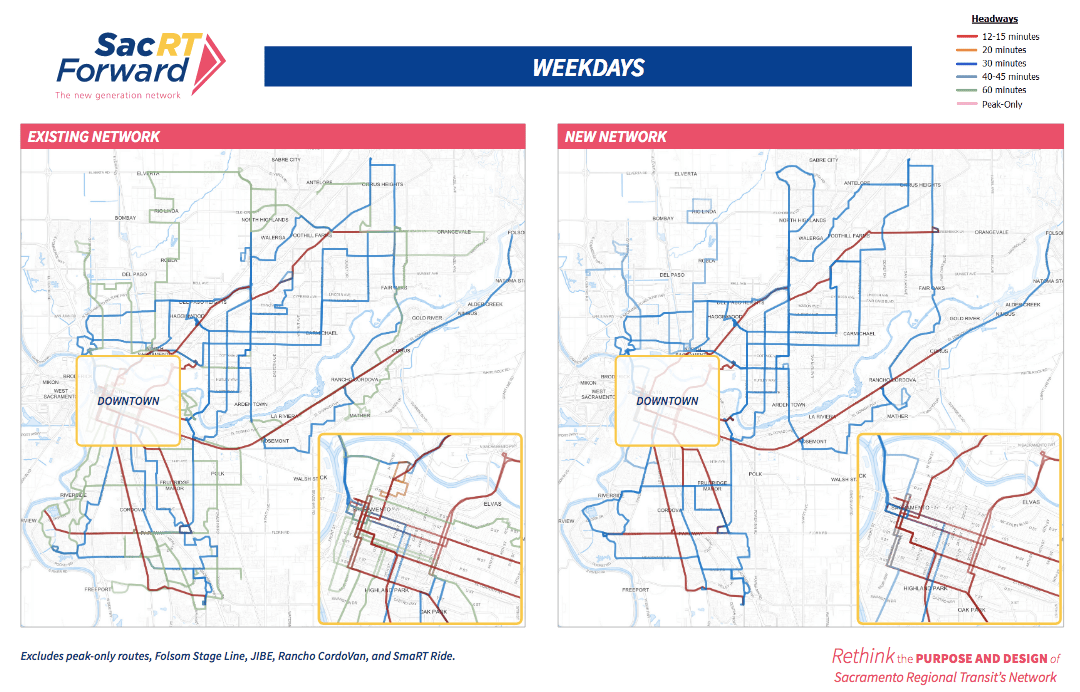Note: GJEL Accident Attorneys regularly sponsors coverage on Streetsblog San Francisco and Streetsblog California. Unless noted in the story, GJEL Accident Attorneys is not consulted for the content or editorial direction of the sponsored content.
For years Sacramento's bus system adjusted to a growing population and budget constraints with incremental changes, adding routes and cutting service to meet immediate needs. Last year the agency decided it was time to take a different approach. Using a grant from the state's Sustainable Communities Planning Grant program, Sacramento Regional Transit—SacRT—set out to ask what kind of bus network would best serve the most people in the region.
This week, the agency's board approved a draft plan it hopes will come close to being the best bus network possible, given its current budget. Starting tonight SacRT will hold workshops to show the public what planners have come up with and ask what needs changing. The first workshop is at 5 p.m. tonight at 1400 29th Street, Sacramento, accessible by light rail to the 29th Street Station or bus routes 38, 67 or 68. Another workshop will be held tomorrow in Rancho Cordova, and two more workshops will be held next week. Workshop details are at the SacRT website.
In the first outreach phase, SacRT Forward--the planning team--put together draft alternatives to help riders and potential riders think about the kinds of trade-offs they needed to consider. There were two extremes to consider: increased coverage, or the areas that would be served; or increased frequency of service. Planners created illustrations for each route, showing exactly what the trade-offs would entail. They also estimated how many more residents and jobs could be served by the various scenarios.

Early feedback from the public made it clear that the lack of weekend and evening service, and only once-and-hour bus service, was just not good enough. But, says a staff report on that feedback:
The community understood the choice between higher frequency/ridership model versus the coverage model. Overall, the majority of community input favored more frequent service, but clearly recognized coverage as an important goal, and that balancing the two is a difficult task.
SacRT routes serve a vast area, stretching from Elk Grove to Folsom to North Natomas to the Sacramento River. Some of those places are suburban and sprawly, and it's difficult to serve them efficiently with buses. In contrast, in the central area people live and work in a slightly denser pattern.
It's a trade-off many transit agencies face because of constrained budgets. But it's not an even one, especially in terms of rider numbers. Generally transit experts, including Jarrett Walker, who was hired by SacRT to consult on this plan, maintain that higher ridership results from higher frequency service, while trying to cover a wider area—which typically means low frequency service—detracts from ridership. More frequent service increases the convenience and usefulness of a bus route, but politics often favor more spread-out coverage, and some riders may need to access farther-flung areas. Still, it isn't possible to run frequent service everywhere.
A complicating factor is another bit of feedback planners got to their first round of outreach: many respondents told the agency that fares are just too high, especially for families that depend on the bus. In response, the board temporarily lowered fares to $2.50 in October, with the issue to be revisited later.
The agency ended up proposing a simpler, more frequent network overall. Their plan reduces the total number of bus routes from 46 to 21, eliminating some low-ridership routes and consolidating others. It also increases the frequency of most routes, and adds weekend service.
And it stays within the existing budget.
The plan doesn't quite get to a service frequency that would make a schedule unnecessary—that would be about every ten to fifteen minutes—but it eliminates once-an-hour service throughout the system. Headways on the new network will range from 15 to 45 minutes, depending on route and time of day.
“If we had more money, we could do more short headways, where our timetables don't really matter any more,” SacRT spokesperson Jessica Gonzalez told Streetsblog. “That would be the ultimate plan, and something to work towards. But with this we had to work within our existing budget.”
She emphasized that the draft network is a work in progress. “It's not perfect, and there will be changes made as we get more feedback,” she said. “We really want to hear from people whether this will work, and what changes are needed.”
To make up for eliminating some of the lower-rider routes, SacRT will rely on a slight expansion of its existing SmaRT Ride program. This shuttle service, which costs riders about the same as a bus ride, provides door-to-door shared rides within a specific area, getting residents to services, shopping, and transit hubs. Using vehicles smaller than buses and focusing on a local area allows the agency to provide shared rides more efficiently than with a full bus network, and makes riding transit much more convenient for its users.
The proposed bus network takes advantage of existing frequencies on the light rail lines, and seeks to match schedules with those lines. It also proposed improvements to several transit hubs connecting various services.
During the next 45 days, SacRT staff plans to visit each route and talk to riders, give presentations to neighborhood associations and other groups, present open houses, and generally be available to hear people's comments. Gonzalez urges Sacramento residents to attend an open house—in addition to the four that are currently scheduled, there will be more to come in January. People can study materials on the agency's website and email comments to SACRTForward [at] sacrt.com.
A video presentation will be available to further explain the changes at some point in January.
“Plus anyone can request a presentation for a neighborhood association or group like that,” said Gonzalez.
People will want to look at their own route, and to that end an interactive map showing the changes proposed for each individual route will be available soon. There is also a summary of changes for each route [PDF].
Staff's goal is to have the changes implemented this coming June. “If we miss that date, we can't implement until September, because of bus driver route assignments,” said Gonzalez. “It all depends on the feedback we get, and on whether the board agrees.”
“People have a voice right now in shaping this. We want to know how to make this most usable for the most people. We're not going to make every single person happy, but we want to figure out what will be the best system, and what will be the best for the Sacramento region as a whole.”
Follow Streetsblog California on Twitter @StreetsblogCal






